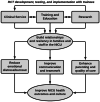Caring for our caretakers: building resiliency in NICU parents and staff
- PMID: 35804198
- PMCID: PMC9395886
- DOI: 10.1007/s00431-022-04553-1
Caring for our caretakers: building resiliency in NICU parents and staff
Abstract
The neonatal intensive care unit (NICU) is a high-acuity, stressful unit for both parents and staff. Up to 50% of mothers and partners experience emotional distress (i.e., depression, anxiety, or posttraumatic stress) during NICU hospitalization and 30-60% continue to experience distress after discharge. Similarly, up to 50% of NICU staff report burnout and emotional distress. Although healthcare providers have developed interdisciplinary guidelines to enhance psychosocial resources for parents and staff, standardized psychosocial services are lacking. The purpose of this short communication is to describe: (1) the need for psychosocial interventions for NICU parents and staff; (2) existent psychosocial programs and their gaps and limitations; and (3) future directions for psychosocial care in NICU settings. We reviewed the current literature and propose a new conceptual model to inform psychosocial interventions for the NICU. We argue that brief, evidence-based, resiliency, and relationship-based programs are needed to enhance parent and staff outcomes and, ultimately, child development and the NICU unit culture.
Conclusion: Given the lack of standardized psychosocial care, new interventions for NICU families and staff are needed more than ever. Resiliency, relationship-based interventions that leverage multidisciplinary support may be an innovative way to enhance NICU outcomes and care.
What is known: • 40-50% of parents in the NICU report elevated emotional distress and 30-50% of staff report burnout. • Psychosocial interventions for parents and staff are needed, yet lacking.
What is new: • Interventions that focus on resiliency and relationships may improve the culture of the NICU. • New multidisciplinary collaborations and approaches are needed to improve implementation.
Keywords: Neonatal intensive care; Parents; Postpartum; Psychosocial care.
© 2022. The Author(s), under exclusive licence to Springer-Verlag GmbH Germany, part of Springer Nature.
Conflict of interest statement
The authors declare no competing interests.
Figures

Similar articles
-
SUPPORTING PRETERM INFANT ATTACHMENT AND SOCIOEMOTIONAL DEVELOPMENT IN THE NEONATAL INTENSIVE CARE UNIT: STAFF PERCEPTIONS.Infant Ment Health J. 2016 Mar-Apr;37(2):160-71. doi: 10.1002/imhj.21556. Epub 2016 Mar 3. Infant Ment Health J. 2016. PMID: 26938792
-
Psychosocial support for parents of extremely preterm infants in neonatal intensive care: a qualitative interview study.BMC Psychol. 2019 Nov 29;7(1):76. doi: 10.1186/s40359-019-0354-4. BMC Psychol. 2019. PMID: 31783784 Free PMC article.
-
Support needs of parents in neonatal intensive care unit: An integrative review.J Clin Nurs. 2022 Mar;31(5-6):532-547. doi: 10.1111/jocn.15972. Epub 2021 Jul 26. J Clin Nurs. 2022. PMID: 34312923 Review.
-
Recommendations for enhancing psychosocial support of NICU parents through staff education and support.J Perinatol. 2015 Dec;35 Suppl 1(Suppl 1):S29-36. doi: 10.1038/jp.2015.147. J Perinatol. 2015. PMID: 26597803 Free PMC article. Review.
-
Parents' experiences of transition when their infants are discharged from the Neonatal Intensive Care Unit: a systematic review protocol.JBI Database System Rev Implement Rep. 2015 Oct;13(10):123-32. doi: 10.11124/jbisrir-2015-2287. JBI Database System Rev Implement Rep. 2015. PMID: 26571288
Cited by
-
NICU Parent and Staff Advocacy to Address Parental Mental Health.Clin Pediatr (Phila). 2025 Feb;64(2):247-256. doi: 10.1177/00099228241260167. Epub 2024 Jun 10. Clin Pediatr (Phila). 2025. PMID: 38853718 Free PMC article.
-
A biopsychosocial model of NICU family adjustment and child development.J Perinatol. 2023 Apr;43(4):510-517. doi: 10.1038/s41372-022-01585-1. Epub 2022 Dec 22. J Perinatol. 2023. PMID: 36550281 Free PMC article.
References
Publication types
MeSH terms
Grants and funding
LinkOut - more resources
Full Text Sources

